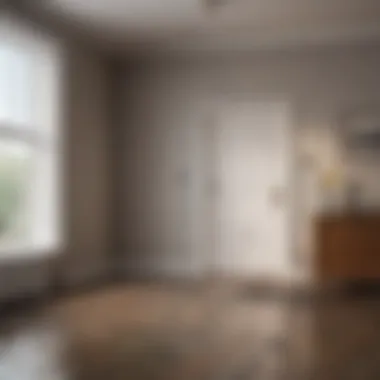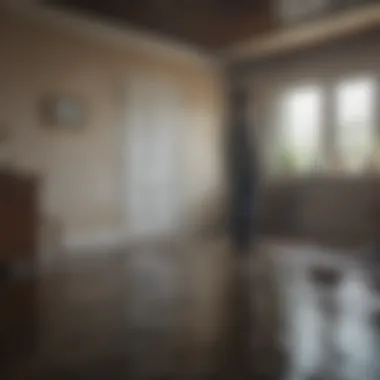House Insurance and Water Leak Coverage Insights


Intro
Understanding the connection between house insurance and water leaks is vital for homeowners. Water damage can lead to significant repair costs and can affect structural integrity. This article seeks to strip away the complexities surrounding insurance coverage related to water leaks. We will discuss various types of coverage, common exclusions, and the implications of filing claims for water damage. Homeowners must grasp their responsibilities and make informed decisions on how best to protect their property.
Coverage Options
Homeowners need to understand what coverage is available to deal with water-related issues. Insurance policies can differ widely, and knowing the types of coverage can lead to more effective protection.
Types of Coverage Available
Several forms of coverage can address water leak-related claims. These include:
- Dwelling Coverage: This covers damage to the physical structure of the home caused by water leaks from problems like roof failure or plumbing issues.
- Personal Property Coverage: This aspect includes protection for items within the home, which can be damaged due to water leaks.
- Additional Living Expenses: If a water leak renders a home uninhabitable, this coverage helps cover costs for temporary housing.
- Flood Insurance: This type of policy is crucial if your house is in a flood-prone area. Standard homeowner insurance often does not cover flood damage.
Liability Coverage Explained
Liability coverage might not directly relate to water leaks, but it can carry significant implications. If a neighbor's property sustains damage from water leaking from your home, liability coverage may respond to those claims. This aspect helps protect homeowners from lawsuits arising from accidental damage to others’ property.
Key Considerations
Selecting the right insurance policy involves more than just choosing coverage types. Homeowners should consider several factors before committing to an insurance provider.
Factors to Assess When Choosing Insurance
When evaluating policies, homeowners should consider:
- The policy's coverage limits for water damage and flooding.
- The deductibles that apply and if they are realistically manageable.
- The insurance company's reputation and customer support track record in handling claims efficiently.
- Any exclusions that could limit coverage, especially regarding age or condition of plumbing systems.
Understanding Policy Limits
Every insurance policy has limits on what it will cover. Homeowners must carefully read the terms to ensure they have adequate protection against potential losses. Coverage limits for water damage can vary significantly, which can impact the amount recoverable in a claim. A clear understanding of these limits can make all the difference during stressful times when water damage occurs.
Prolusion to House Insurance and Water Damage
House insurance serves as a vital safety net for homeowners, particularly when faced with unexpected events like water leaks. Understanding the intricate relationship between house insurance and water damage is essential for avoiding financial pitfalls. Water can wreak havoc on property; therefore, comprehending coverage options can be the difference between significant loss and effective recovery.
As homeowners assess their insurance needs, they must consider how water damage is classified and covered within their policies. This article aims to bridge the knowledge gap regarding house insurance and water damage. Through insight into policy details, exclusions, and homeowner responsibilities, readers can make informed decisions to better protect their assets.
Overview of House Insurance
House insurance, commonly referred to as homeowners insurance, provides financial protection against a variety of risks associated with owning a home. This insurance typically covers the structure itself, personal property, and liability in case someone is injured on the property. Different types of policies exist, each with its own scope of coverage and limitations.
Within this framework, understanding water damage coverage becomes critical. Policies often vary significantly in the scope of what constitutes covered water damage. Homeowners need to be acutely aware of both the inclusions and exclusions of their specific policies. This understanding can potentially save time and, more importantly, money.
The Importance of Understanding Water Damage Coverage
Water damage is one of the most common claims made under house insurance policies. However, a lack of awareness about what is covered can lead to disputes when claims are made. Thus, grasping the nature of water damage coverage is crucial.
Insurance policies often delineate water damage into categories, such as sudden water leaks versus gradual leaks. While sudden leaks might be covered, gradual damage may not be.
Furthermore, specific events such as flooding may require separate coverage. In many cases, homeowners may find themselves underinsured if they fail to secure this additional coverage. This points to the importance of discussing policy details thoroughly with an insurance agent to ensure adequate protection.
"A comprehensive understanding of your insurance policy is your best defense against unexpected home damage."
Ultimately, being well-informed fosters better decision-making regarding house insurance. Homeowners can navigate the complexities and nuances of water damage coverage more effectively, minimizing future risks.


Types of Water Damage
Understanding the types of water damage is critical when it comes to house insurance. Different types of damage carry various implications for coverage and claims. Knowing the distinctions allows homeowners to tailor their insurance needs appropriately.
Sudden Water Leaks
Sudden water leaks can occur due to various reasons. Often, they result from pipe bursts, appliance malfunctions, or poor plumbing. This type of water damage is generally covered by standard homeowners insurance, provided the leak is sudden and not a result of neglect.
When a sudden leak happens, it is essential to act quickly. Homeowners should shut off the water supply to mitigate damage, and contact professionals for repairs. Insurance companies usually require prompt notification of the incident. This ensures that coverage can be activated. Claims for sudden water leaks can be filed if the homeowner has documented the damage properly.
Gradual Water Damage
Gradual water damage, on the other hand, unfolds over time. It may stem from long-term issues like slow leaks from pipes, seepage from the foundation, or inadequate drainage. Unfortunately, most standard house insurance policies do not cover this type of damage. Policyholders often find themselves responsible for repairs and restoration costs.
Homeowners must routinely monitor for signs of gradual water damage. This includes looking for discoloration on walls, damp spots, or mold growth. Identifying these early reduces risks and can lead to a better chance of remediation before extensive damage occurs.
Flooding and Its Distinction from Other Water Damage
Flooding is a specific and often misunderstood form of water damage. Unlike sudden leaks or gradual damage, flooding typically results from external sources of water, such as heavy rainfall, hurricanes, or melting snow. Standard homeowners insurance usually does not cover flood damage. Homeowners must secure separate flood insurance policies, especially if they live in high-risk areas.
Flooding carries significant consequences for homeowners. Flood insurance is a necessity in many regions, particularly where government agencies classify areas based on flood zones. Homeowners should not underestimate potential risks; understanding flood zones and obtaining proper insurance can safeguard against financial loss.
"Homeowners insurance covers sudden water leaks, but excludes gradual damage and flooding, emphasizing the importance of tailored coverage."
In summary, distinguishing between types of water damage is vital for homeowners. Each can affect their insurance policies and potential claims. Awareness ensures preparedness and informed decisions regarding necessary coverage.
Coverage for Water Damage in House Insurance
Understanding coverage for water damage in house insurance is essential for any homeowner. Water damage can occur unexpectedly, causing not only physical harm to the property but also financial strain. Therefore, knowing what your insurance policy covers can significantly impact your ability to recover from such incidents. This section will discuss standard coverage, exclusions, and how different policies may vary, ensuring homewoners can make informed decisions about their insurance needs.
Standard Coverage Scope
Most standard homeowners' insurance policies include coverage for certain types of water damage. Generally, this may cover sudden or accidental leaks, like those caused by a burst pipe or damage from an appliance such as a washing machine. Homeowners need to familiarize themselves with the specifics of their policy. Here are some common features of standard coverage:
- Sudden Water Leaks: This is usually covered if the leak results from an unforeseen event.
- Appliance Failure: Damage from malfunctioning appliances is often included in the coverage.
- Water Damage from Firefighting Efforts: If fire department efforts to extinguish a fire cause water damage, this typically falls under coverage.
Homeowners should pay attention to their specific policy documents to understand the extent of their coverage.
Exclusions in Water Damage Coverage
While standard policies provide certain protections, exclusions exist. These exclusions can significantly impact how homeowners manage water damage. Common exclusions include:
- Flood Damage: Most homeowner policies do not cover flood damage caused by natural floods.
- Gradual Damage: Damage that occurs over time instead of suddenly is usually not covered. For example, a slow leak from a pipe causing mold will likely fall under this exclusion.
- Negligence: If the homeowner fails to maintain their property, it's possible that coverage could be denied.
Understanding these exclusions is crucial. Homeowners should proactively consider additional flood insurance or other riders to enhance their protection against potential water damage.
Comparing Different Insurance Policies
Not all homeowners' insurance policies are created equal. When reviewing coverage, it is wise to compare different policies, focusing on water damage. Here's what to consider when comparing:
- Coverage Limits: Determine the maximum payout for water damage claims. This can vary widely between policies.
- Deductibles: Evaluate the amounts you are required to pay out of pocket before coverage kicks in. Some policies may have higher deductibles for water damage.
- Additional Endorsements: Look for options like sewer backup or specific water damage coverage. These can enhance protection against scenarios not included in standard policies.
"Being informed about what each type of coverage entails can prevent significant losses in the future."
In summary, discerning the nuances of coverage for water damage in house insurance requires careful attention to detail. By understanding what is covered, recognizing exclusions, and comparing policies, homeowners can better position themselves against the risks associated with water-related incidents.


Making a Claim for Water Damage
Making a claim for water damage is a critical step for any homeowner facing water-related issues. Proper understanding of this process can lead to swift resolution and necessary financial restitution. Failure to navigate this process correctly can result in the denial of a claim, leaving the homeowner to shoulder the burden of repair costs alone.
The claim process involves several specific elements to ensure that the claim is valid and adequately handled. For homeowners, knowing the different stages can maximize their chances of receiving a fair settlement. This section breaks down the essential steps needed post-water leak and emphasizes the importance of documenting damage, thereby facilitating a smooth claims route.
Steps to Take After a Water Leak
When a water leak occurs, it is crucial to act quickly to minimize further damage. Here are the immediate steps to take:
- Identify the Source: Locate where the leak is originating. This could be a broken pipe, faulty appliance, or roof leakage.
- Stop the Leak: If possible, turn off the water supply to prevent additional flooding.
- Document the Situation: Take photos or videos of the leak, the surrounding area, and any damage caused. This evidence will be invaluable when making a claim.
- Contact Your Insurance Provider: Notify your insurer about the water damage as soon as possible. They can guide you through the claims process.
- Start the Cleanup: If safe, begin the cleanup process to mitigate further damage. Be sure to document your cleanup efforts as well.
- Store Damaged Items: Keep damaged belongings for inspection by the insurance adjuster, if possible.
By following these steps, homeowners establish an organized approach that will aid in their claim process.
Documenting Damage for Your Claim
Accurate documentation of damage is essential for a successful insurance claim. Keep the following tips in mind:
- Photographs: Capture clear images of the affected areas, making sure to show before and after the cleanup process. Pictures of the source of the leak are also significant.
- List of Damages: Create an itemized list of damaged property. Include descriptions, estimated values, and date of purchase.
- Repair Estimates: Collect quotations from repair professionals. This shows the extent of damage and provides a financial estimate for repairs.
- Witness Accounts: If relevant, gather statements from neighbors or friends who witnessed the damage.
Good documentation serves as strong proof when negotiating with your insurance company.
Understanding the Claims Process
Navigating the claims process can appear overwhelming, but understanding the basic structure can simplify it:
- Claim Submission: After documenting the damage, formally submit your claim to your insurer. Ensure that all necessary paperwork is included.
- Adjuster Review: An insurance adjuster will likely be assigned to your case. They will review your claim, inspect the damage, and evaluate the financial impact.
- Decision and Payment: Once the review is complete, the insurer will either approve the claim or provide an explanation for any denial. If approved, payment will follow, or you may receive a check for repairs.
- Follow-Up: If there are issues or delays, don’t hesitate to follow up with the insurer. Keeping in communication can expedite the process.
Understanding this process allows homeowners to approach claim filing with informed confidence, knowing what to expect and how to address potential issues promptly.
Preventative Measures Against Water Damage
Preventative measures against water damage play a crucial role in protecting homes and property. Understanding and implementing these strategies can mitigate risks associated with water leaks and other water-related issues. It is vital for homeowners to recognize that proactive steps can save both time and money.
Water damage can be costly and disruptive. By focusing on prevention, one can reduce the likelihood of extensive repairs, emotional distress, and impacts on insurance premiums. These measures not only safeguard personal property but also enhance the overall value of a home. Proper maintenance creates a secure environment and reassures family members regarding safety.
Regular Maintenance Checks
Conducting regular maintenance checks throughout the home is essential. This can include inspecting roofs, plumbing systems, and drainage solutions. A thorough examination helps to identify potential problems, making it easier to address them before they escalate.
Homeowners should consider the following maintenance tasks:
- Inspect roofs for leaks: Look for missing shingles or tiles and check seams.
- Examine gutters and downspouts: Ensure they are clear of debris to maintain proper drainage and prevent overflow.
- Check basement and crawl space: Look for signs of moisture or mold to allow for timely corrective actions.
- Test sump pumps: Regularly verify that sump pumps are working as intended.
Regular checks do not need to be time-consuming. A structured schedule of seasonal or biannual inspections can suffice. By making it routine, one is likely to find potential issues early, translating to significant savings in repairs and insurance claims.
Common Areas Prone to Water Leaks
Certain areas of a home are more susceptible to water leaks, and knowing them can help in prioritizing maintenance efforts. Common leak-prone areas include:
- Bathroom: Around toilet bases, sinks, and bathtubs where water usage is high.
- Kitchen: Underneath sinks and around dishwashers, faucets, and ice makers.
- Laundry Room: Around washing machines and hoses that connect to them.
- Water Heater: Check connections, valves, and sediment build-up that can lead to leaks.
To prevent leaks in these areas, regular inspection and maintenance should not be overlooked. Homeowners can also benefit from installing monitoring systems that can alert them to leaks immediately, allowing for prompt action.
"A proactive approach to maintenance can prevent many water-related problems before they start."


In summary, prioritizing preventative measures against water damage is essential for safeguarding the home. Regular maintenance checks and awareness of common leak-prone areas are necessary strategies. With constant vigilance, homeowners can enjoy peace of mind while protecting their investment.
Seeking Additional Coverage
In the context of house insurance, seeking additional coverage is essential for homeowners. Water damage can result in significant financial burdens that typical policies may not fully cover. Understanding this aspect can substantially enhance one’s protection against unforeseen water-related incidents.
When navigating through house insurance, homeowners must realize that standard coverage often excludes certain types of water damage. This realization can lead to financial strain when an unexpected leak occurs. Therefore, exploring additional options is vital for ensuring comprehensive protection. Homeowners can tailor their policies to include coverage types that address specific risks their properties face.
Water Backup Coverage
Water backup coverage is one crucial addition homeowners should consider. This type of coverage safeguards against damages resulting from sewer or drain backups. Traditional policies might not cover such events, leaving homeowners to shoulder the financial burden of repairs.
With water backup coverage, homeowners can claim expenses incurred from water damage caused by failed sewer systems. This coverage typically protects personal belongings, flooring, and structural components of the home. Homeowners should clearly understand the limits of this coverage, as some policies have specific regulations regarding coverage amounts and deductibles.
A few key aspects include:
- Scope of Coverage: Understand which losses are included under water backup coverage.
- Policy Limits: Review the maximum payout applicable to water backup claims.
- Additional Premiums: Be prepared for potential extra costs, as this coverage generally incurs additional charges.
Flood Insurance Considerations
Flood insurance is another vital element to contemplate for homeowners. Flooding can occur unexpectedly, causing extensive damage to properties and often leading to devastating financial consequences. It is important to note that most house insurance policies do not cover flooding, making separate flood insurance necessary in many cases.
When considering flood insurance, homeowners should focus on several factors:
- Eligibility: Determine if your area requires flood insurance based on geographical flood zone classifications.
- Coverage Options: Understand the distinction between personal property and structure coverage when selecting a flood insurance policy.
- Waiting Periods: Be aware that many flood insurance policies have waiting periods before they take effect, which can impact immediate response to a flood event.
Adding flood insurance can be especially valuable for those living in high-risk areas. Homeowners should regularly assess their risks and consider investing in this essential additional coverage. By proactively securing water backup and flood insurance, individuals enhance their protection against water-related damages that standard policies often overlook.
Legal Considerations Related to Water Damage and Insurance
Navigating the realm of house insurance in relation to water damage involves not just understanding policies but also comprehending the legal framework surrounding these issues. Homeowners must be aware of their rights and responsibilities when it comes to water damage. This knowledge is crucial as it directly influences their ability to file claims and receive appropriate compensation. Additionally, understanding these legal aspects can aid in avoiding potential pitfalls that could arise during the claims process.
Understanding Your Rights as a Homeowner
Homeowners have a set of rights that protect them under various circumstances, especially regarding water damage. First, your insurance policy should clearly outline what is covered and what is excluded. If a claim is denied or tried to be minimized, homeowners reserve the right to seek clarification from their insurers. Understanding the terms and conditions ensures that one is fully informed about coverage limits and exclusions.
Moreover, you have the right to receive timely responses from your insurance company. If you report a water leak, the insurer must act promptly to assess the damage. Should they fail to do so, homeowners may explore further legal action. Additionally, state laws often dictate what is reasonable in terms of response time and how claims must be handled, so it is beneficial to familiarize yourself with these regulations.
Documentation is also a key right; homeowners can keep records of communications and damage assessments. This helps in substantiating claims and ensuring fair treatment during the entire process.
The Role of Public Adjusters
When managing a water damage claim, public adjusters serve as independent advocates for homeowners. Their primary role is to evaluate damage and prepare paperwork for insurance claims, ensuring accuracy and thoroughness. They are hired directly by the policyholder, not by the insurance company, which allows them to provide unbiased and comprehensive assessments of the situation.
Public adjusters help in various ways:
- Assessment of Damage: They evaluate the extent of the water damage carefully, which can lead to a more accurate claim.
- Claim Preparation: They assist in compiling necessary documentation and estimates to support the claim.
- Negotiation: These professionals negotiate with the insurance company on behalf of the homeowner, often leading to better outcomes.
This support is particularly important when dealing with complex claims or where large sums are involved. A public adjuster’s expertise can mitigate the stress associated with the claims process and improve the likelihood of a fair settlement.
Ending and Final Thoughts
Navigating the world of house insurance in relation to water leaks requires a nuanced understanding. This article highlights the critical aspects involved, focusing on coverage details and exclusions associated with water damage. Property owners often face the ramifications of water leaks, not just in terms of immediate damage, but also concerning financial implications and claims processes.
Clear comprehension of one's insurance policy is essential for homeowners. Knowing what is covered can prevent unexpected expenses and provide peace of mind. For instance, common exclusions in water damage coverage could include gradual leaks or flooding, which may not be part of a standard policy. Therefore, understanding these nuances empowers homeowners to take informed decisions regarding their coverage options.
Furthermore, homeowners must consider their responsibilities in managing water-related issues effectively. Proper documentation and timely communication with insurance providers are vital during a claim process. Being proactive can significantly ease these processes during stressful situations.
A thorough grasp of house insurance provisions influences not only claim outcomes but also ensures personal financial stability in the face of unexpected water damage.
Now, the final thoughts of this discussion advocate for a heightened awareness of maintaining properties and evaluating insurance coverage regularly. The involvement of public adjusters and legal rights understanding can also enhance a homeowner's negotiating power and clarity in claims processes.



